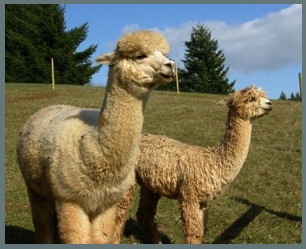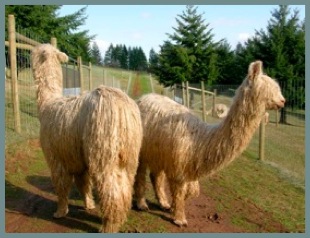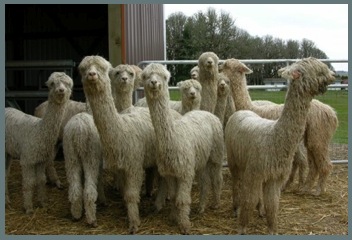The Alpaca (Vicugna pacos) is a domesticated species of South American camelid. It resembles a small llama in superficial appearance. They have coexisted with humankind for thousands of years. Alpacas were a cherished treasure of the ancient Incan civilization and played a central role in the Incan culture that was located on the high Andean Plateau and mountains of South America. The Incas clothed themselves in garments made from alpaca and many of their religious ceremonies involved the animal as well.
Alpacas were first imported to the United States in 1984. Alpacas are now being successfully raised and enjoyed throughout North America and abroad. There are two types of alpacas - the Huacaya and the Suri pictured here.
The lifespan of the alpaca is about 20 years and gestation is 11.5 months. Alpacas eat grasses and chew cud. Adult alpacas are about 36" tall at the withers and generally weigh between 100 and 200 pounds. They are gentle and easy to handle. Alpacas don't have incisors, horns, hooves or claws. Clean-up is easy since alpacas deposit droppings in only a few places in the paddock. They require minimal fencing and can be pastured at 5 to 10 per acre.
Of the various camelid species, the alpaca and vicuña are the most valuable fiber-bearing animals: the alpaca because of the quality and quantity of its fiber, and the vicuña because of the softness, fineness and quality of its coat. Alpacas are too small to be used as pack animals. Instead, they were bred exclusively for their fiber. The fleece is sheared from the animal annually.
Soft as cashmere and warmer, lighter and stronger than wool, it comes in more colors than any other fiber producing animal, 52 natural colors as classified in Peru, 12 as classified in Australia and 16 as classified in the United States. This cashmere-like fleece, once reserved for Incan royalty, is now enjoyed by spinners and weavers around the world. Alpaca fiber is used for making knitted and woven items, much as sheep's wool is. These items include blankets, sweaters, hats, gloves, scarves, a wide variety of textiles in South America, designer coats, suits and sweaters in other parts of the world.
Alpaca owners enjoy a strong and active national organization. The Alpaca Owners and Breeders Association (AOBA) with a growing number of Regional Affiliates and AOBA sanctioned national committees addressing every aspect of the industry.
The Alpaca Fiber Cooperative of North America (AFCNA) accepts fleece from its members, and turns the precious textile into quality alpaca garments and products. Members benefit from a ready outlet for their fiber, while the cooperative works to increase awareness of and demand for this every day luxury.
The Alpaca Registry (ARI) has been established to help ensure accurate records and has a state-of the-art system to document bloodlines. Alpacas must be blood typed through DNA samples in order to be registered. Virtually every alpaca in the U.S. is registered.
Contact Us - Steve Hall - Laura Hall


